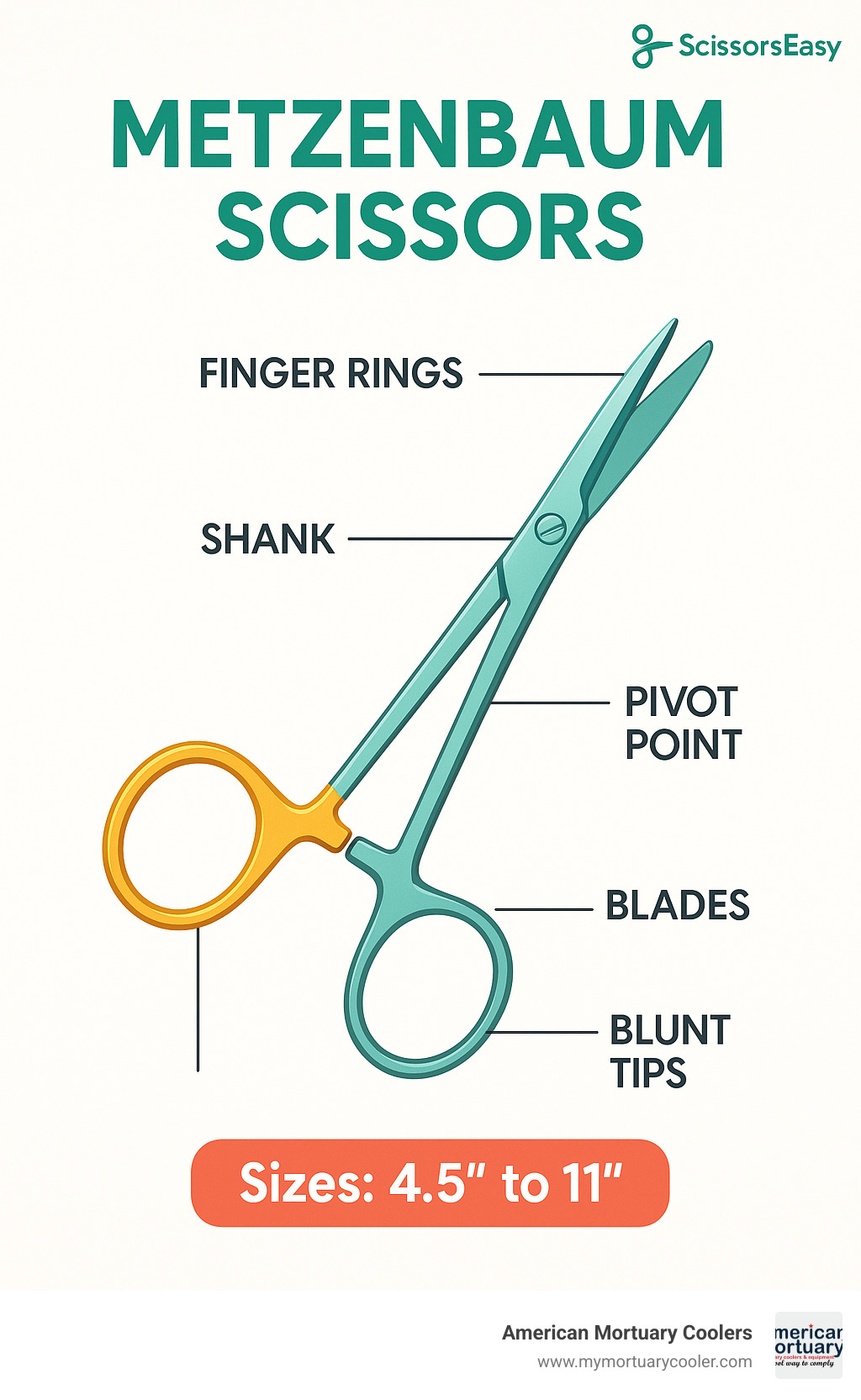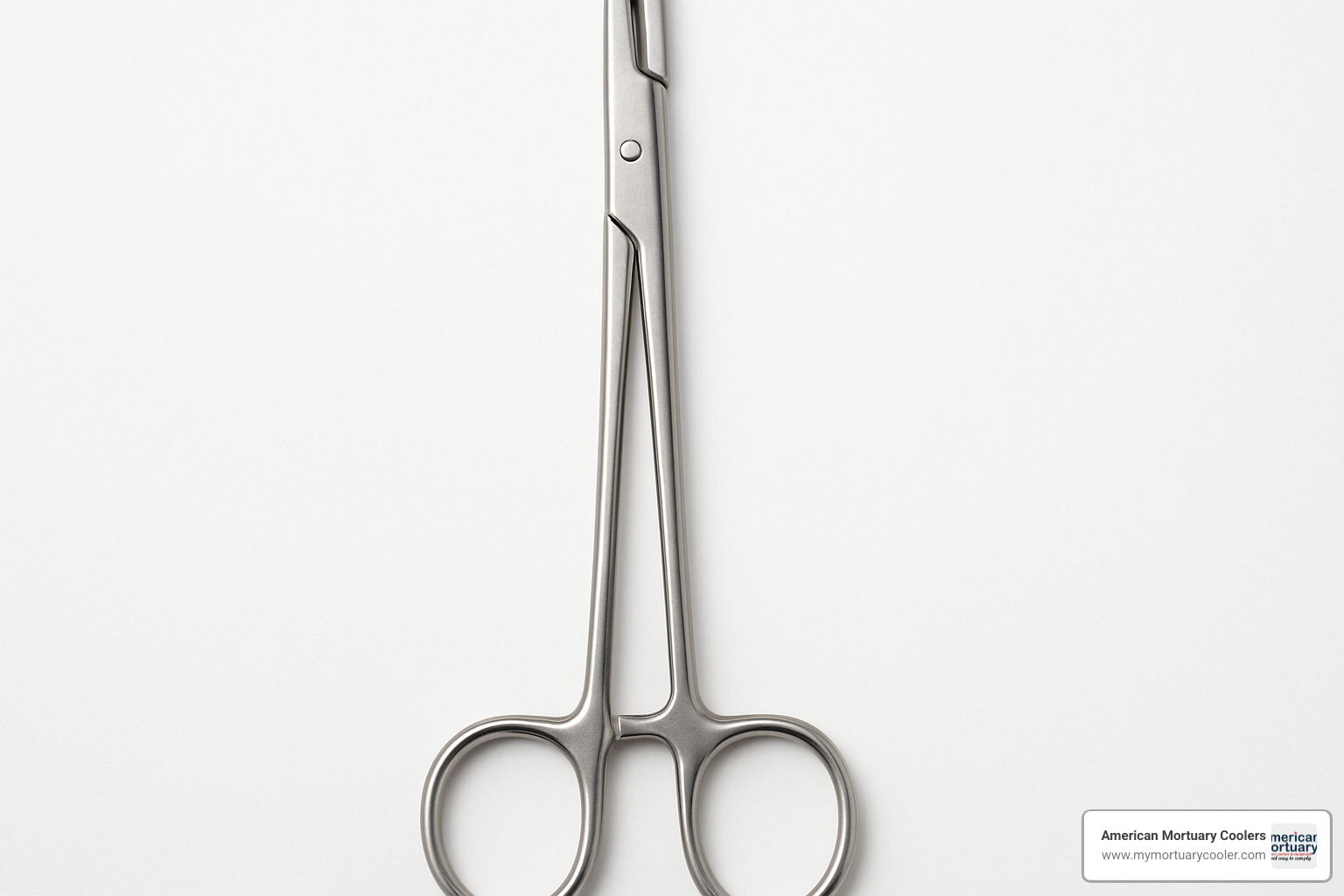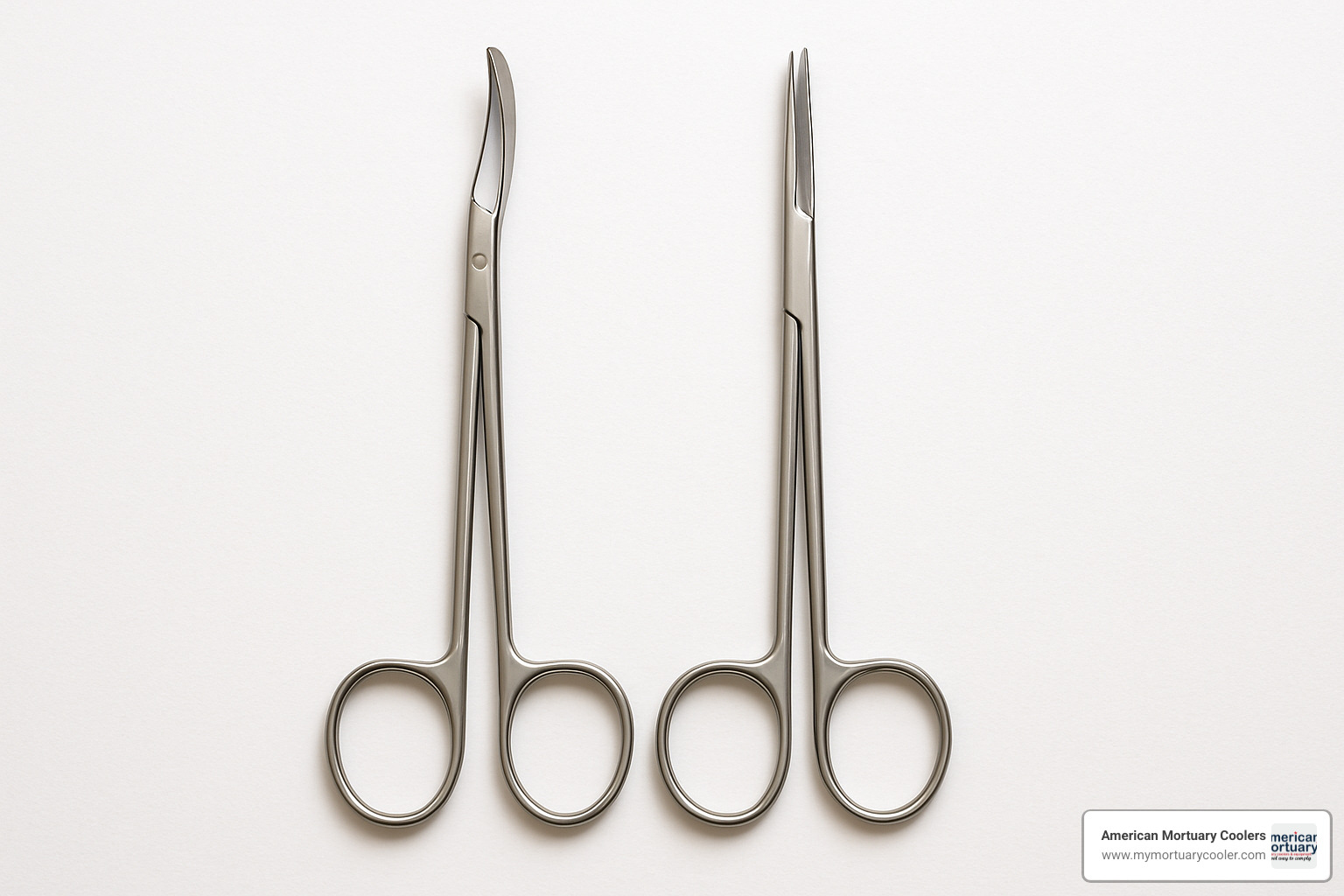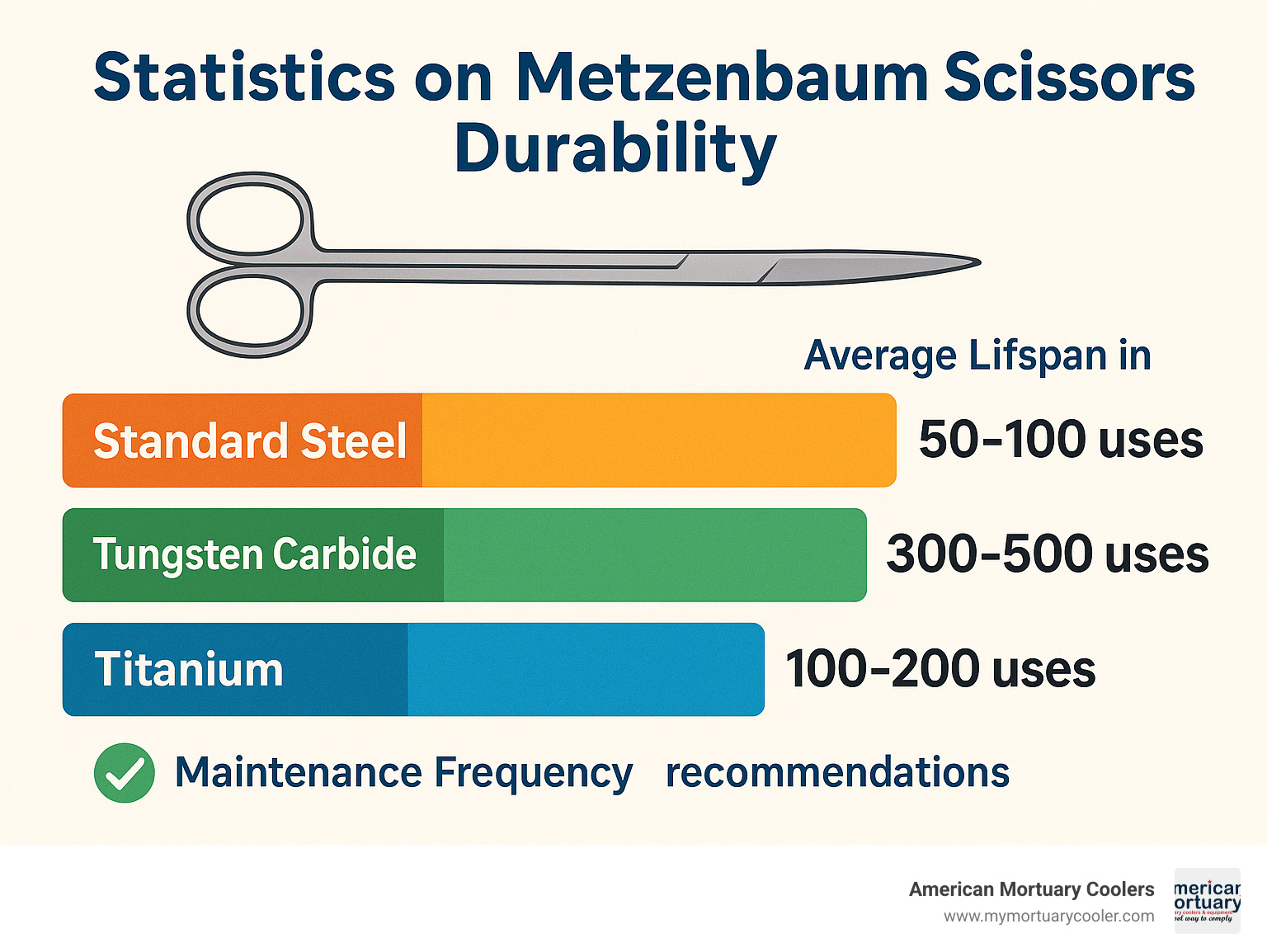Essential Surgical Tools: Understanding Metzenbaum Scissors
Metzenbaum scissors are specialized surgical instruments designed for cutting delicate tissue and performing blunt dissection during surgical procedures. These precision tools are essential in modern surgery and post-mortem examinations.
Quick Facts About Metzenbaum Scissors:
- Purpose: Delicate tissue dissection and blunt dissection
- Named after: Dr. Myron Firth Metzenbaum (1876-1944)
- Materials: Stainless steel, often with tungsten carbide inserts
- Sizes: Available in lengths from 4.5" (11.5 cm) to 11" (28 cm)
- Key feature: High shank-to-blade ratio for precise control
- Not recommended for: Cutting sutures, drains, or heavy tissue
Metzenbaum scissors stand out from other surgical scissors due to their slim, blunt tips and thin, delicate shafts that minimize damage to surrounding tissues. They're the most common type of scissors used in organ-related operations, thanks to their precision and control.
These scissors are available in both curved and straight variations, with the curved design being particularly useful for accessing confined surgical spaces. The blades can be improved with tungsten carbide inserts, which can extend the cutting performance up to six times longer than standard stainless steel.
I'm Mortuary Cooler, a national-level mortuary cooler supplier with experience in mortuary equipment including surgical instruments like metzenbaum scissors used in post-mortem procedures. My work with funeral homes has given me knowledge of the crucial role these precision instruments play in both surgical and mortuary settings.

Quick metzenbaum scissors terms:
Metzenbaum Scissors Overview: Definition & History
Ever wonder who's behind the neat surgical tool that surgeons reach for when delicate work is needed? Metzenbaum scissors weren't just named randomly – they have a fascinating backstory tied to a brilliant medical mind.
These precision instruments came to life in the 1920s, created by Dr. Myron Firth Metzenbaum, an innovative American surgeon who lived from 1876 to 1944. Dr. Metzenbaum wasn't just looking for another cutting tool – he was solving a specific surgical challenge: how to dissect delicate tissues without damaging surrounding structures.
What makes Metzenbaum scissors special is their exceptional design for blunt dissection – that careful technique of separating tissues along natural planes without cutting through them. This approach dramatically reduces bleeding and helps preserve vital structures during surgery. It's no surprise they've become the go-to scissors for organ-related operations nearly a century later!
Dr. Metzenbaum's background in reconstructive surgery gave him unique insight into the need for gentler tools. Working primarily as an otolaryngologist (that's an ear, nose, and throat doctor for those of us who don't speak medical jargon), he understood that surgical success often depended on precision and tissue preservation. His scissors were designed with exactly these priorities in mind.
According to scientific research on Myron Metzenbaum, his contributions went far beyond just this one instrument, though it remains his most enduring legacy in operating rooms worldwide.
Origins of the Name
The name behind these famous scissors has roots in Cleveland's rich medical history. Dr. Myron Metzenbaum wasn't just any surgeon – he was a Cleveland native who became a cornerstone of the city's medical community.
His primary expertise was in otolaryngology, where he pioneered techniques for addressing congenital defects in the ear, nose, and throat. His innovative approaches to reconstructive surgery earned him respect throughout the medical community, but it's his contribution to surgical tools that ensured his name would be remembered daily in operating rooms around the world.
What's particularly charming is how deeply embedded the Metzenbaum name has become in surgical culture. In ORs everywhere, you'll hear surgeons simply ask for "Metzs" – and every surgical tech knows exactly which instrument to hand over. That kind of linguistic shorthand speaks volumes about Dr. Metzenbaum's lasting impact on surgical practice.
His surgeon-inventor legacy lives on not just in the name, but in the countless delicate procedures these scissors have made possible over the decades. From the Cleveland operating rooms where Dr. Metzenbaum first practiced to modern surgical suites worldwide, his innovation continues to touch patients' lives every day – a remarkable legacy for any medical professional.
Structural Features, Materials & Sizes
The magic of Metzenbaum scissors lies in their thoughtful design. If you've ever held a pair, you'll notice their distinctive high shank-to-blade ratio – this isn't just for show. This clever design gives surgeons better leverage and control when working in those tricky, confined spaces where precision matters most.

Safety comes first with these scissors – that's why they feature blunt tips that help prevent those heart-stopping accidental nicks to vital structures during delicate procedures. The cutting edges run nearly the entire length of the blade from pivot to tip, giving the user consistent cutting power exactly where it's needed.
When it comes to materials, quality is non-negotiable. Standard Metzenbaum scissors are crafted from surgical-grade stainless steel that stands up to rigorous use and sterilization. For those seeking next-level performance, many premium models feature tungsten carbide inserts along the cutting edges. These remarkable inserts aren't just a fancy upgrade – they can extend cutting performance up to six times longer than standard steel blades. That's value that adds up over time!
Comfort matters during long procedures, which is why these scissors feature ergonomic finger rings that reduce hand fatigue. The slightly offset design feels natural in the hand, whether you're performing a delicate surgery or a careful post-mortem examination.
Key Dimensions of Metzenbaum Scissors
Finding the right size Metzenbaum scissors for the job makes all the difference. These versatile tools come in lengths ranging from petite 4.5-inch (11.5 cm) models to substantial 11-inch (28 cm) versions, with plenty of options in between.
Here's a comparison of common size options:
| Length | Common Applications | Best For |
|---|---|---|
| 4.5" (11.5 cm) | Ophthalmological, plastic surgery | Very fine, superficial work |
| 5.5" (14 cm) | ENT, pediatric surgery | Delicate work in small spaces |
| 7" (18 cm) | General surgery, gynecology | Standard tissue dissection |
| 9" (23 cm) | Abdominal surgery, urology | Deeper tissue planes |
| 11" (28 cm) | Thoracic, bariatric surgery | Very deep surgical fields |
The slim, neat shaft design is another hallmark of Metzenbaum scissors. This slender profile isn't just about aesthetics – it provides excellent visibility and access to tight spaces without blocking the view. When working around delicate structures like blood vessels and nerves, this thoughtful design proves its worth time and again.
Material Options Explained
While stainless steel remains the trusted standby, today's Metzenbaum scissors come in several material variations to suit different needs and preferences.
German Surgical Stainless Steel models represent the gold standard. Crafted from high-carbon stainless steel, these instruments offer exceptional corrosion resistance and edge retention. At American Mortuary Coolers, we've seen these German-forged instruments perform beautifully in both surgical and post-mortem settings – they're an investment that pays dividends in reliability.
You can spot Tungsten Carbide (TC) Metzenbaum scissors by their distinctive golden ring handles – a bit of flash that serves a practical purpose by making them easy to identify. These scissors aren't just showing off; the TC inserts can extend functional life up to six times compared to standard models. Yes, they cost more upfront, but the math makes sense when you consider how long they last.
For those long, complex procedures where every gram matters, Titanium Alloy Metzenbaum scissors offer a lightweight alternative that's about 25% lighter than steel models. Your hands will thank you! Titanium also resists corrosion beautifully, though you'll pay a premium for these benefits.
Some specialized variations include SuperCut and Super-Sharp models with micro-serrated edges on one blade working against a straight edge on the other. This clever configuration gives you better grip on slippery tissues – a small detail that can make a big difference when precision counts.
Choosing the right material comes down to how you'll use the scissors, how often you'll reach for them, and of course, budget considerations. But whatever your choice, a quality pair of Metzenbaum scissors is an essential companion for anyone working with delicate tissues.
Variations & Comparative Insights
Metzenbaum scissors come in a fascinating variety of shapes and styles, each designed with specific surgical needs in mind. If you've ever watched surgeons at work, you might notice they often request different scissor types depending on what they're doing. Let's explore these variations and how they compare to other surgical scissors.

The most common distinction you'll see is between curved and straight Metzenbaum scissors. The curved versions feature a gentle, neat arc that follows natural body contours. This clever design gives surgeons better visibility when they're working deep inside the body. Imagine trying to see around a corner – that's essentially what the curve helps with, especially when working around rounded structures like blood vessels or in deep abdominal procedures.
Straight Metzenbaum scissors, meanwhile, offer more direct cutting action. They're the go-to choice for surface work or when surgeons need to make precise, straight cuts. Many surgeons develop a preference based on their training and the types of procedures they typically perform.
Beyond the basic curved/straight distinction, Metzenbaum scissors gets even more specialized. You'll find super-sharp versions with extra-keen cutting edges for the most delicate tissues. There are super-cut models with tiny serrations that grip slippery tissues (think of them like the difference between a smooth knife and a bread knife). For minimally invasive procedures, endoscopic Metzenbaum scissors have been developed, while microsurgery specialists often reach for the ultra-fine micro versions. And if you spot a pair with distinctive golden rings on the handles, you're looking at the premium tungsten carbide models that stay sharp much longer than standard versions.
Curved, Straight & Super Variants
Would you believe there are over 200 different patterns and variations of Metzenbaum scissors available today? It's true! The design has evolved to meet incredibly specific surgical needs since Dr. Metzenbaum's original invention.
The tips of these scissors also come in different configurations. Most common are the blunt/blunt tips, which are safest for general tissue work since they minimize the risk of accidentally poking or tearing delicate structures. For more versatility, some surgeons prefer sharp/blunt hybrids – one pointed blade paired with one blunt blade. This combination allows both cutting and blunt dissection with a single instrument. Less frequently used but valuable in certain scenarios are sharp/sharp configurations, which offer more precise initial tissue penetration.
Some specialty Metzenbaum scissors feature micro-serrated edges that help grip tissues that might otherwise slip away during cutting. Think about trying to cut through a tomato with a dull knife versus a serrated one – the same principle applies with slippery tissues.
In our work at American Mortuary Coolers, we've noticed that while the standard blunt-tipped versions are most commonly used in post-mortem procedures, the versatile sharp/blunt hybrid models are popular when technicians need to perform both precise cutting and gentle dissection in the same examination.
Metzenbaum Scissors vs. Mayo Scissors
"Can you pass me the Metzs, not the Mayos?" This is a request heard in operating rooms worldwide, but what's the difference between these two common surgical scissors?
Metzenbaum scissors and Mayo scissors might look similar to the untrained eye, but they serve distinctly different purposes. Metzenbaum scissors are the delicate artists of the surgical world – lighter, more refined, with longer, slender blades designed for the gentle touch needed around vital structures. They're like fine paintbrushes, creating minimal tissue disturbance.
Mayo scissors, by contrast, are the workhorses – sturdier, with shorter, stronger blades built to handle tougher tissues. They're designed for cutting denser materials like fascia and even sutures (which would damage the delicate Metzenbaum scissors). Mayo scissors feel more substantial in your hand, with broader tips and a robust construction.
In a typical procedure, you might see Mayo scissors used for the initial work – cutting through skin and outer tissue layers – followed by Metzenbaum scissors for the more delicate dissection around vital structures. Using the wrong scissors for a task isn't just inefficient; it can damage the instruments or, more importantly, the patient's tissues.
At American Mortuary Coolers, we recommend having both types available in any comprehensive surgical or post-mortem setting. It's like having both a chef's knife and a paring knife in your kitchen – each has its purpose, and together they handle nearly any cutting task with appropriate precision and care.
Surgical Applications & Best Practices
When it comes to delicate tissue work, Metzenbaum scissors truly shine. These precision instruments have found their way into operating rooms across numerous surgical specialties, each valuing the scissors' ability to handle tissues with minimal trauma.
In urology, surgeons rely on Metzenbaum scissors when working around the delicate structures of the urinary tract, where precision can mean the difference between success and complication. Gynecologists treasure them during procedures involving the female reproductive system, where tissue preservation is paramount. Cardiovascular surgeons find them invaluable for the meticulous work around blood vessels and cardiac tissues, where even the smallest error can have significant consequences.

ENT specialists particularly appreciate Metzenbaum scissors when navigating the confined spaces of ear, nose, and throat procedures, where the slender profile allows for excellent visibility. Neurosurgeons, working with perhaps the most delicate tissues of all, depend on their precision when dissecting near neural structures. Even our veterinary colleagues have adopted these scissors across various animal procedures where tissue preservation matters just as much as in human surgery.
The main technique used with Metzenbaum scissors is blunt dissection – a gentle approach that separates tissues along their natural planes without cutting. Picture a surgeon carefully inserting the closed scissors into tissue, then gently opening them to create space between layers. This technique minimizes bleeding and preserves vital structures that might otherwise be damaged with more aggressive approaches.
When cutting is necessary, the long, slender blades of Metzenbaum scissors allow for remarkably controlled tissue division. Their unique high shank-to-blade ratio gives surgeons excellent leverage, resulting in precise control over both cutting pressure and depth – even in deep surgical fields where visibility might be limited.
In my work with funeral homes across Tennessee and beyond at American Mortuary Coolers, I've seen how Metzenbaum scissors are just as essential in post-mortem examinations. Pathologists rely on their precision during autopsies, where preserving tissue integrity remains crucial for accurate examination and sampling.
Advantages of Metzenbaum Scissors in Delicate Tissue
What makes Metzenbaum scissors so special for delicate tissue work? Their design offers several distinct advantages that surgeons and pathologists have come to appreciate.
The slim, tapered blades enable precision cutting that's crucial when working around vital structures like nerves and blood vessels. This precision isn't just about convenience – it actively minimizes collateral damage to surrounding tissues, which can significantly impact healing and outcomes.
The blunt tips and controlled cutting action of Metzenbaum scissors reduce tissue trauma compared to sharper instruments. This gentler approach matters tremendously in live surgical settings where tissue healing is a concern. It's equally important in post-mortem examinations where preserving tissue integrity for analysis often determines the quality of findings.
I've always been impressed by how the slender profile of Metzenbaum scissors allows them to access narrow surgical corridors without blocking the surgeon's view. This access to confined spaces is invaluable during procedures involving deep body cavities or small anatomical spaces where visibility is already challenging.
The ergonomic handle design and balanced weight distribution provide excellent tactile feedback – allowing professionals to literally "feel" tissue planes and apply precisely the right amount of pressure needed for dissection. This sensory feedback is something surgeons often mention when discussing why they prefer these scissors for their most delicate work.
While primarily designed for soft tissue work, Metzenbaum scissors perform both cutting and blunt dissection techniques, making them remarkably versatile. This versatility explains why they're often the first instrument surgeons reach for when approaching delicate tissues.
Limitations & Contraindications
Despite their versatility, Metzenbaum scissors aren't suitable for every cutting task – understanding their limitations is just as important as appreciating their strengths.
Never use Metzenbaum scissors for cutting sutures. This is perhaps the most important rule to remember. The delicate blades can be permanently damaged by the dense material of suture threads, leading to premature dulling or even notching of the cutting edges. Always reach for dedicated suture scissors instead – your Metzenbaum scissors will thank you with years of continued service.
Heavy tissues are off-limits. These scissors weren't built for cutting through dense tissues like fascia, ligaments, or tendons. Attempting to cut these materials not only produces poor results but can permanently damage your scissors. Mayo scissors, with their sturdier build, are a much better choice for these applications.
Synthetic materials can be problematic. Similar to sutures, cutting drainage tubes or other synthetic materials with Metzenbaum scissors can quickly damage their precision blades. Always use specialized scissors designed specifically for synthetic materials in these situations.
Size matters in instrument selection. It's essential to match the size and type of Metzenbaum scissors to your specific procedure. Using scissors that are too large for a confined space or too small for a deep surgical field compromises both efficiency and safety. This is why most surgical sets include multiple sizes.
At American Mortuary Coolers, I always emphasize proper instrument selection when talking with funeral homes and medical facilities. Understanding these limitations not only extends the life of valuable instruments but ensures they perform optimally when called upon. After all, the right tool used the right way makes all the difference – whether in surgery or in the careful work of post-mortem examination.
Care, Maintenance & Purchasing Guide
Taking good care of your Metzenbaum scissors isn't just about protecting an investment—it's about ensuring these precision instruments perform perfectly when you need them most. At American Mortuary Coolers, we've worked with funeral homes from Johnson City to Chicago, and we've seen how proper maintenance makes all the difference.

When it comes to sterilization, Metzenbaum scissors handle standard autoclave procedures beautifully. Just be sure to clean off all biological material first—especially around that tricky pivot area where gunk loves to hide. Most models handle temperatures between 121-134°C without complaint, though it's always smart to check the manufacturer's guidelines.
After your scissors take their steam bath, show them some love with a drop of medical-grade lubricant at the pivot point. This small step makes a world of difference, especially for the fancy tungsten carbide models. Think of it as giving your scissors a tiny spa treatment—they work hard, they deserve it!
Even the finest Metzenbaum scissors eventually lose their edge. Standard stainless models typically need sharpening after 30-50 uses, while their tungsten carbide cousins might go 150-300 uses before dulling. When that time comes, skip the DIY approach—these precision instruments deserve professional sharpening that maintains their exact geometry.
Before each use, give your scissors a quick once-over. Are the blades aligned properly? Do they open and close smoothly? Any nicks or damage to the cutting edges? Is the pivot screw nice and tight? Any signs of corrosion? This 30-second check can save you from finding a problem mid-procedure.

Selecting the Right Metzenbaum Scissors
Choosing the perfect Metzenbaum scissors is a bit like finding the right pair of shoes—it's all about the right fit for the job.
For procedure-specific length, think about how deep you'll be working. Those cute little 4.5-5.5" scissors are perfect for superficial work, while the longer 9-11" models reach comfortably into deeper cavities. In our experience working with funeral homes across the Southeast, we've found that 7" scissors hit the sweet spot for most post-mortem applications—not too short, not too long, just right.
The curved versus straight decision often comes down to the anatomy you're working with. Curved Metzenbaum scissors follow natural body contours and let you see better in deep spaces. Straight models give you more direct cutting action when you're working on the surface. When in doubt, having one of each nearby never hurts.
If your scissors get heavy use, splurging on tungsten carbide (TC) inserts makes good financial sense. Yes, they cost more upfront, but they stay sharp so much longer that the math works out in your favor. For occasional use, standard stainless models will serve you well without breaking the bank.
Don't underestimate the importance of how scissors feel in your hand. Some folks prefer lighter handles for delicate work, while others appreciate a bit more heft for stability. If possible, try before you buy—your hands will thank you during long procedures.
Pricing & Suppliers
Metzenbaum scissors come in a wide range of prices that reflect their quality and features. Basic stainless steel models typically run $80-$100, while mid-range options with improved features land in the $100-$150 territory. If you're looking at premium tungsten carbide models, expect to invest $150-$300. The specialized titanium versions lighten both your instrument tray and your wallet at $200-$400.
These scissors are clearly in high demand—Amazon alone moved over 4,000 Metzenbaum scissors in a recent month. That's a lot of cutting and dissecting!
German-forged brands have earned their reputation as the gold standard for surgical instruments. They typically back their products with more generous warranties too—often 5+ years for tungsten carbide models compared to just 1-3 years for standard versions.
If you're setting up a new facility or restocking an existing one, ask about bulk discounts. Many suppliers offer 10-25% off when you purchase multiple instruments at once. At American Mortuary Coolers, we're happy to connect our clients with reputable suppliers of high-quality surgical instruments that complement our mortuary cooler solutions. After all, having the right tools makes every job easier—whether it's preserving remains or performing delicate dissections.
Frequently Asked Questions about Metzenbaum Scissors
Can Metzenbaum scissors cut sutures?
One of the most common questions we hear at trade shows is whether Metzenbaum scissors can pull double-duty as suture cutters. The short answer is a definite no – and there's a good reason for this.
These delicate instruments are precision-crafted for soft tissue work, and using them on dense suture materials is a bit like using your fine china to hammer nails. The tough suture threads will quickly damage those carefully-honed cutting edges, leaving you with dulled or notched blades that no longer glide smoothly through delicate tissues.
For suture cutting, you'll want to reach for dedicated suture scissors instead – like Spencer stitch scissors or suture removal scissors. These workhorses are specifically designed to handle the tough stuff without complaint.
In our travels to funeral homes from Dallas to New York, we've noticed something interesting – the facilities with the lowest replacement costs are invariably those that maintain dedicated tools for each specific purpose. It might seem like an extra expense upfront, but those Metzenbaum scissors will thank you with years of faithful service when they're used only for their intended purpose.
What sizes do Metzenbaum scissors come in?
Metzenbaum scissors come in a variety of lengths to suit different needs – think of them like different paintbrushes for different artistic tasks. The most common sizes you'll encounter include:
The petite 4.5-inch (11.5 cm) scissors are perfect for delicate work in ophthalmology and plastic surgery, where precision in small spaces is paramount. Moving up to 5.5 inches (14 cm), these are popular choices for ENT procedures and pediatric applications where a bit more reach is needed.
The 7-inch (18 cm) models are the Swiss Army knife of the Metzenbaum world – versatile enough for general surgery and many post-mortem applications. This mid-range option offers a nice balance of control and reach.
For deeper work, the 9-inch (23 cm) scissors provide extended reach for abdominal procedures, while the substantial 11-inch (28 cm) models are designed for the deepest surgical fields, such as bariatric surgery.
From our experience outfitting funeral homes throughout the Midwest and Northeast, we typically recommend maintaining at least two different sizes – usually a 5.5" and a 7" pair – to handle the variety of tasks that come up in post-mortem care. This combination gives you versatility without breaking the bank.
How often should Metzenbaum scissors be sharpened?
Knowing when to sharpen your Metzenbaum scissors is a bit like knowing when to change your car's oil – it depends on how hard you're driving them. Several factors come into play: how frequently they're used, what materials they're cutting, and what type of scissors you've invested in.
For standard stainless steel models, plan on sharpening after about 30-50 uses, or when you notice they're not cutting as smoothly as they once did. If you've splurged on tungsten carbide models (those fancy ones with the golden rings), you'll enjoy a much longer interval – typically 150-300 uses before they need attention.
The specialized Super-Cut or serrated edge models fall somewhere in between, generally requiring professional attention after 75-150 uses. And I do mean professional – these precision instruments deserve expert care, not a quick pass on whatever sharpening tool happens to be handy.
One thing we've noticed while visiting facilities across the Rocky Mountains and Southwest is that the most successful maintenance approach isn't based on calendar days, but on a regular inspection routine. Taking a moment to check your instruments before each use helps catch dulling before it affects your work quality.
And remember – if those scissors have been used for anything they shouldn't have (looking at you, suture cutters), all bets are off on these intervals. Using Metzenbaum scissors on materials they weren't designed for can turn that 150-use lifespan into a single-digit number faster than you can say "oops."
Conclusion
The journey through Metzenbaum scissors reveals how thoughtful design can transform surgical practice. From their humble beginnings in Dr. Myron Metzenbaum's Cleveland practice in the 1920s to today's advanced versions with tungsten carbide edges and titanium construction, these precision instruments have stood the test of time for good reason.

Here at American Mortuary Coolers, we see parallels between these specialized instruments and our own custom-built mortuary refrigeration solutions. Just as a skilled surgeon selects the perfect Metzenbaum scissors for delicate tissue work, we craft cooling systems custom to each funeral home's specific needs across the country.
What stands out most about Metzenbaum scissors is their staying power. Nearly a century after their invention, they remain irreplaceable in operating rooms worldwide. That kind of enduring utility only comes from exceptional design meeting a genuine need – something we strive for in our own mortuary coolers.
The care taken with these instruments speaks volumes about the professionals who use them. Surgeons and mortuary professionals alike understand that precision tools demand respect – using them only for their intended purpose, maintaining them carefully, and inspecting them carefully before each use.
When you invest in quality instruments like premium Metzenbaum scissors, you're not just buying a tool – you're investing in better outcomes. The same philosophy guides our approach to mortuary refrigeration. We'd rather build you a cooler that serves faithfully for decades than one that needs replacing in a few years.
Whether you're performing delicate dissections or caring for the deceased with dignity, having the right tools makes all the difference. We're proud to serve funeral professionals across Johnson City TN, Pittsburgh PA, and throughout the United States with the same attention to detail that Dr. Metzenbaum brought to his scissors.
For more information about our custom mortuary coolers and other equipment for funeral homes, please don't hesitate to contact us. We deliver durable, custom solutions directly to facilities in all 48 contiguous states, bringing the same precision and care to our work that you bring to yours.


















